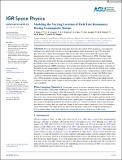Files in this item
Modeling the varying location of field line resonances during geomagnetic storms
Item metadata
| dc.contributor.author | Elsden, Tom | |
| dc.contributor.author | Yeoman, T. K. | |
| dc.contributor.author | Wharton, S. J. | |
| dc.contributor.author | Rae, I. J. | |
| dc.contributor.author | Sandhu, J. K. | |
| dc.contributor.author | Walach, M-T. | |
| dc.contributor.author | James, M. K. | |
| dc.contributor.author | Wright, D. M. | |
| dc.date.accessioned | 2022-09-09T11:30:18Z | |
| dc.date.available | 2022-09-09T11:30:18Z | |
| dc.date.issued | 2022-01 | |
| dc.identifier | 281239065 | |
| dc.identifier | cd1b7a6a-ffea-45b8-8fb1-f5c95de1c2fa | |
| dc.identifier | 85124405396 | |
| dc.identifier.citation | Elsden , T , Yeoman , T K , Wharton , S J , Rae , I J , Sandhu , J K , Walach , M-T , James , M K & Wright , D M 2022 , ' Modeling the varying location of field line resonances during geomagnetic storms ' , Journal of Geophysical Research: Space Physics , vol. 127 , no. 1 , e2021JA029 . https://doi.org/10.1029/2021JA029804 | en |
| dc.identifier.issn | 2169-9402 | |
| dc.identifier.other | ORCID: /0000-0002-1910-2010/work/118799811 | |
| dc.identifier.uri | https://hdl.handle.net/10023/25986 | |
| dc.description | Funding: T. Elsden was supported by a Leverhulme Trust Early Career Fellowship (ECF-2019-155), the University of Leicester and the University of Glasgow. I. J. Rae was supported by NERC Grants NE/P017185/1 and NE/V002554/2 and STFC Grant ST/V006320/1. T. K. Yeoman and M. K. James were supported by STFC Grant ST/S000429/1. J. K. Sandhu was supported by NERC Grants NE/P017185/2 and NE/V002554/2. M-T Walach was supported by NERC Grant NE/T000937/1. | en |
| dc.description.abstract | Previous observational studies have shown that the natural Alfvén frequencies of geomagnetic field lines vary significantly over the course of a geomagnetic storm, decreasing by up to 50% from their quiet time values outside the plasmasphere. This was recently demonstrated statistically using ground magnetometer observations across 132 geomagnetic storm events (Wharton et al., 2020). This then brings into question where field line resonances (FLRs) will form in storm-time conditions relative to quiet times. With storm-time radiation belt dynamics depending heavily upon wave-particle interactions, understanding how FLR locations change over the course of a storm will have important implications for this area. Using 3D magnetohydrodynamic (MHD) simulations, we investigate how changes in the Alfvén frequency continuum of the Earth's dayside magnetosphere over the course of a geomagnetic storm affect the fast-Alfvén wave coupling. By setting the model Alfvén frequencies consistent with the observations, and permitting a modest change in the plasmapause/magnetopause locations consistent with storm-time behavior, we show that FLR locations can change substantially during storms. The combined effects of higher fast waveguide frequencies and lower Alfvén frequencies during storm main phases, act together to move the FLR locations radially inwards compared to quiet times. FLRs outside of the plasmasphere are moved radially inward by 1.7 Earth radii for the cases considered. | |
| dc.format.extent | 19 | |
| dc.format.extent | 3358605 | |
| dc.language.iso | eng | |
| dc.relation.ispartof | Journal of Geophysical Research: Space Physics | en |
| dc.subject | GE Environmental Sciences | en |
| dc.subject | QA Mathematics | en |
| dc.subject | QC Physics | en |
| dc.subject | DAS | en |
| dc.subject.lcc | GE | en |
| dc.subject.lcc | QA | en |
| dc.subject.lcc | QC | en |
| dc.title | Modeling the varying location of field line resonances during geomagnetic storms | en |
| dc.type | Journal article | en |
| dc.contributor.institution | University of St Andrews. Applied Mathematics | en |
| dc.identifier.doi | https://doi.org/10.1029/2021JA029804 | |
| dc.description.status | Peer reviewed | en |
| dc.date.embargoedUntil | 2022-07-06 | |
| dc.identifier.url | http://eprints.gla.ac.uk/263351/ | en |
This item appears in the following Collection(s)
Items in the St Andrews Research Repository are protected by copyright, with all rights reserved, unless otherwise indicated.

